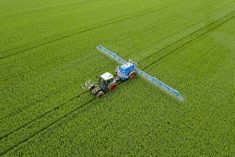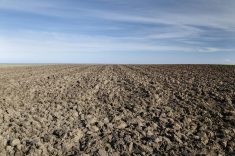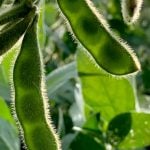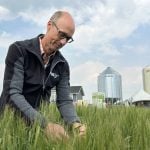“My father’s generation could grow wheat without any problems. The present generation can hardly grow a bushel of wheat without the use of fungicides.”
– Gerald Wi Ebe
Prior to the Second World War, “chemical” agriculture didn’t exist.
In Gerald Wiebe’s opinion, it’s all been downhill ever since for farmers, their soil and consumers.
In a presentation of insights gained from a decade of organic farming and voracious consumption of literature on the subject, the Manitouarea farmer was critical of the chemical-based agronomic pract ices of the so-cal led “Green Revolution.”
Read Also

Manitoba sees cabbage seed pod weevil surge
Cabbage seed pod weevil has crossed into true canola pest territory in Manitoba this year, following years of minimal population counts
Citing peer-reviewed research articles, Wiebe argued that not only have farmers lost control of the profitability of their operations, but the health of the soil and the nutritional quality of the food grown on it has suffered.
That’s because chemical agriculture ignores the important role played by bacteria, fungi and other soil critters in sustaining healthy plants, he said.
“Their focus is on input versus output, and not at all on the quality of the output.”
The most damning evidence of modern agriculture’s failings, he said, is widespread mineral deficiencies found in food grown under chemically intensive methods.
DENSITY
He cited a study done in Europe that compared the mineral density of vegetables from 1940 with those grown in 1991. It found the content of key minerals such as copper had fallen by up to 76 per cent.
“In other words, vegetables in 1991 have about 40 per cent of the mineral content that the same vegetables had before World War Two,” he said, adding that the same also holds true for fruit.
If farmers were paid for quality of production, not just sheer volume, then conventional producers would see 40 per cent less for the same commodities than what they got in 1940, he added.
A potentially “huge” new trend in the food business may be aiming to rectify that situation, he noted. As health-conscious consumers learn about food mineral density, buyers and processors are starting to pay premiums for it, and many companies now use biochemical analysis to guide their purchasing decisions.
“They buy only the highest mineral density. And when you’ve got something that is significantly higher in mineral density, they don’t ask what the price is. They just ask, ‘How much do you want for it?’” he said.
“Food is not just food anymore. There is a big difference between high-quality, mineral-dense food and all the other stuff.”
Some organic farmers particularly the “organic by neglect” crowd are no less guilty of growing second-rate food, he said.
Declining mineral density and other problems such as soil depletion and crop disease problems, Wiebe asserted, can all be resolved by developing and adopting new alternative farm management practices and strategies.
That means paying more attention to the countless organisms that inhabit the rhizosphere the area of the soil immediately surrounding plant roots that Wiebe compared to a complex digestive system not unlike the rumen of a cow.
“Chemical agriculture offers the view that only minerals are important – that so long as we provide N, P, K and sulphur and trace minerals and chemical control of pests, the rest of plant growth will take care of itself,” he said.
FOOD WEB
Biological agriculture, on the other hand, asserts that a healthy, functioning soil food web composed of bacteria, fungi and larger organisms such as earthworms are all required to make minerals available in adequate amounts for growing plants.
Plants, in turn, produce sugars in their roots that feed the organisms in the soil food web. Instead of sterilizing and impoverishing soil with chemical inputs over time, a healthy food web leads to increased levels of organic matter as plants and soil bugs die and become food for successive generations.
“Plants absorb metabolic products that are produced by the rhizosphere,” he said. “Plants feed the rhizosphere, the rhizosphere feeds the plant.”
To thrive, the beneficial microbes need oxygen. That means zero-tillage strategies are fundamentally flawed, said Wiebe. He uses tillage on his farm to aerate the rhizosphere and incorporate crop residue and cover crops such as peas and sweet clover to build soil organic matter instead of trying to preserve what little is left.
Knowledge of the importance of soil microbes and beneficial farming practices has been around for many decades, he said, citing numerous – but unfortunately almost forgotten – books on the subject.
The rise of chemical agriculture in the postwar era, he said, led the world’s farmers into a cul-de-sac where the only solutions to the spread of plant diseases such as fusarium seem to involve even more chemicals or reliance on genetically modified organisms the cost of all of which must be shouldered by the farmer.
“My father’s generat ion could grow wheat without any problems. The present generation can hardly grow a bushel of wheat without the use of fungicides.” [email protected]


















